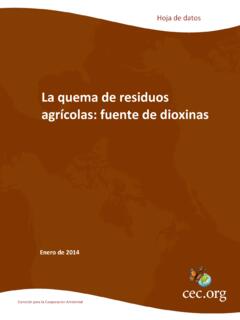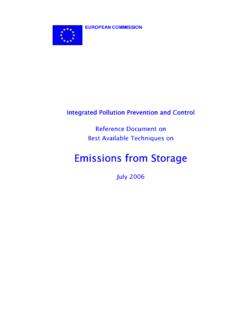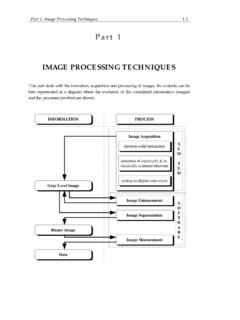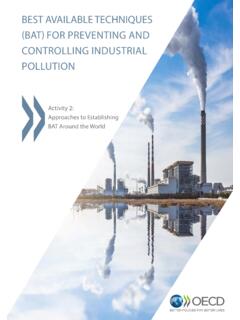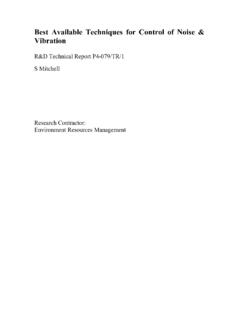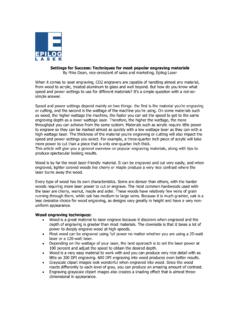Transcription of Best Available Technology for Air Pollution Control ...
1 best Available Technology for Air Pollution Control : Analysis Guidance and Case Studies for North America Prepared for: Commission for Environmental Cooperation (CEC) of North America 393 St-Jacques Street West Montreal, Quebec Canada H2Y 1N9. Prepared by: MJ Bradley & Associates 1000 Elm Street Second Floor Manchester, NH 03101. USA. February 2005. Table of Contents List of Tables .. 5. List of Acronyms .. 6. 8. Background .. 10. New Source Review 10. Prevention of Significant Deterioration Permitting .. 10. Non-attainment Area 10. State Implementation 10. Construction Permitting .. 11. Procedures for BAT 12. Step 1: Identify Possible Control 12. Step 2: Eliminate Infeasible Options .. 12. Step 3: Sort and Rank Feasible Options.
2 12. Step 4: Evaluate Most Effective Option .. 13. Step 5: Select 14. RBLC Overview .. 15. Current Emission Control 19. Raw Materials .. 19. Process 19. Emission Control 19. Nitrogen Oxide 19. Particulate 20. Volatile Organic Compound Controls .. 20. Sulfur Dioxide 22. Information 23. US Federal Regulations .. 23. 24. State 25. Trade 25. Equipment Vendors .. 26. Conference 26. Case Study: Stationary Reciprocating Diesel 27. Project 27. Emission 27. RBLC Database .. 28. Existing US Regulations .. 30. Resources for Emission Control 30. Review of NOx Emission Control Options .. 30. Selective Catalytic Reduction (SCR).. 30. Selective Non-catalytic Reduction (SNCR).. 31. Non-selective Catalytic Reduction (NSCR) .. 31. Combustion Controls.
3 31. Review of CO Emission Control 32. Oxidation Catalyst .. 32. Review of SO2 Emission Control 33. Ultra-low Sulfur Diesel Fuel (ULSD).. 33. BAT Analysis Conclusion .. 33. Case Study: Oil-fired Boiler .. 35. Project 35. Emission 35. RBLC Database .. 35. Existing US Regulations .. 38. Resources for Emission Control 38. Review of NOx Emission Control Options .. 39. Flue Gas 39. Overfire 39. Bias Burner 39. SNCR .. 39. SCR .. 39. Cleaner Fuel 41. Review of SO2 Emission Control 41. Flue Gas Desulfurization .. 41. Cleaner Fuel 41. Review of Particulate Emission Control Options .. 41. Electrostatic 42. 42. Cyclone .. 42. 42. Cleaner Fuel 42. Review of CO Emission Control 42. Good Combustion 43. Oxidation Catalyst .. 43. CO Spray 43. Bat Analysis 43.
4 Case Study: Tire-fueled Concrete 45. Project 45. Emission 48. RBLC Database .. 48. Existing US Regulations .. 48. Emission Control 48. Particulate Control 49. Electrostatic 49. Wet Scrubber .. 49. 50. Cyclone .. 50. Review of NOx Emission Control Options .. 50. Low-NOx Burner (LNB) .. 50. Selective Non-catalytic 51. Selective Catalytic Reduction .. 52. Review of CO Emission Control 52. Good Combustion 52. Oxidation Catalyst .. 52. CO Spray 52. Review of SO2 Emission Control 53. Flue Gas Desulfurization .. 53. BAT Analysis Conclusion .. 53. Appendix A New Source Performance Standards .. 55. Appendix B National Emission Standards for Hazardous Air 57. List of Tables Table 1 Ranking Report for Search Criteria from 16. Table 2 Facility Information from RBLC.
5 17. Table 3 Pollutant Information from RBLC .. 18. Table 4 Results of RBLC NOx Search for Internal Combustion Engines .. 28. Table 5 Results of RBLC CO Search for Internal Combustion Engines .. 29. Table 6 SCR NOx Control Cost Analysis for an Internal Combustion Engine .. 34. Table 7 Results of RBLC NOx Search for Oil-fired 36. Table 8 Results of RBLC PM Search for Oil-fired 37. Table 9 Results of RBLC CO Search for Oil-fired 38. Table 10 SCR NOx Control Cost Analysis for an Oil-fired Boiler .. 40. Table 11 List of US and Canadian Facilities Utilizing Tire-derived Fuel .. 46. List of Acronyms ASTM American Society for Testing and Materials BAT/BACT best Available Technology / best Available Control Technology Btu British thermal unit(s).
6 CAT Caterpillar . CATC Clean Air Technology Center CFR Code of Federal Regulations cfm cubic feet per minute CO carbon monoxide CO2 carbon dioxide EGR exhaust gas recirculation EPA (US) Environmental Protection Agency ESP electrostatic precipitator FGR flue gas recalculation FGD flue gas desulfurization HAP hazardous air pollutant hp horsepower kW kilowatt LAER lowest achievable emission rate LNB low-NOx burner MACT Maximum Achievable Control Technology program NAA Non-attainment Area program NAAQS National Ambient Air Quality Standards NEET New and Emerging Environmental Technologies NESHAP National Emission Standards for Hazardous Air Pollutants NMHC non-methane hydrocarbon NOx nitrogen oxides NSCR non-selective catalytic reduction NSR New Source Review program NSPS New Source Performance Standards program OFA overfire air PM particulate matter ppm parts per million PSD Prevention of Significant
7 Deterioration program RACT reasonably Available Control Technology RBLC RACT, BACT, LAER Clearinghouse SCR selective catalytic reduction SNCR selective non-catalytic reduction SO2 sulfur dioxide SOx sulfur oxides TDF tire-derived fuel THC total hydrocarbons tpy tons per year TTN Technology Transfer Network UHC unburned hydrocarbons ULSD ultra-low sulfur diesel VOC volatile organic compound Introduction This best Available technologies (BAT) analysis guidance manual has been prepared for North American regulatory air quality specialists. The document provides a step-by-step explanation of the BAT analysis process used in the US and includes three case studies, for: 1) stationary reciprocating engines, 2) residual oil fired power plants, and 3) cement kilns fired by used tires.
8 This guidance manual details each step in the BAT analysis process used for stationary source air permitting by the US EPA. In addition to explaining the general principle of each step, the manual illustrates the steps by using the three specific case studies as examples. The BAT analysis steps begin with the identification of each feasible emission Control device for a particular emission source and then proceed to an assessment of environmental, energy and economic impacts of each feasible Control option as a means to determine the best option. This BAT guidance manual explains how to use key information resources, such as EPA's RACT, BACT, LAER Clearinghouse (RBLC). Also, this manual presents techniques for acquiring information from US states that may not Available in the RBLC.
9 Other sources of emission Control Technology information are listed, such as equipment vendors, trade associations, EPA publications and existing regulatory standards ( , new source performance standards [NSPS] under 40 CFR 60, and maximum achievable Control Technology [MACT] standards under 40 CFR 63). The economic impact aspect of the BAT analysis includes specific cost analysis spreadsheets developed from the guidelines given in the EPA Air Pollution Control Cost Manual (EPA 452/B-02-001),1 with an explanation of the key input factors. A listing of informational resources for other source categories is provided, including a list of web site addresses for Technology review documents from vendors as well as a compendium of emission Control trade associations.
10 Ultimately, the outcome of a BAT analysis is the determination of an emission rate that can be achieved. There may be a specific type of emission Control device that is identified by the BAT analysis, but the resulting emission rate is, ultimately, the regulatory requirement within an issued permit. As such, a BAT analysis is done on a case-by-case basis. While industry may not appreciate that the target for BAT is constantly changing, this fact enables the regulatory agencies to push technological advances in emission controls over time. In the US, the requirement to perform a BAT analysis is part of the construction permitting approval process. It is incumbent upon the regulatory permit reviewer to understand emission Control technologies in order to objectively evaluate the BAT.
